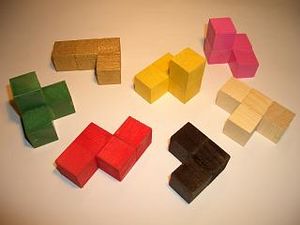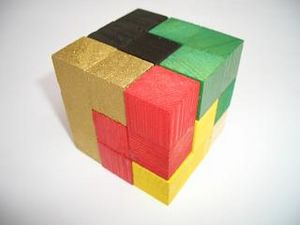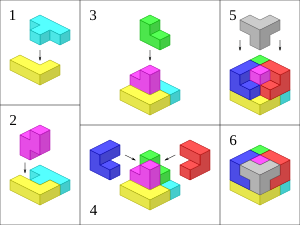Soma cube facts for kids
The Soma cube is a fun and tricky mechanical puzzle. It was invented by a smart person named Piet Hein in 1933. He thought of it during a lecture about quantum mechanics, which is a type of science.
This puzzle has seven special pieces. Each piece is made from small cubes joined together. Your goal is to fit all seven pieces together to make a perfect 3x3x3 cube. You can also use the pieces to build many other cool 3D shapes!
The seven pieces are designed in a special way. One piece is made of three small cubes, and the other six pieces are made of four small cubes. If you add up all the small cubes (3 + 6x4), you get 27. This is exactly how many small cubes fit into a 3x3x3 big cube!
People have studied the Soma cube a lot. A mathematician named John Horton Conway wrote about it in Scientific American magazine in 1958. There are 240 different ways to solve the Soma cube puzzle. That's a lot of solutions! People have even set world records for solving it the fastest. The current record is 2.93 seconds, set by Krishnam Raju Gadiraju from India.
Contents
The Puzzle Pieces
The Soma cube has seven unique pieces. Six of them are made of four small cubes, and one is made of three. Here's what they look like:
 Piece 1, or "V": This piece looks like a "V" shape.
Piece 1, or "V": This piece looks like a "V" shape. Piece 2, or "L": This piece is like three blocks in a row with one block added below the left side, making an "L" shape.
Piece 2, or "L": This piece is like three blocks in a row with one block added below the left side, making an "L" shape. Piece 3, or "T": This piece looks like a "T". It has three blocks in a row with one block added below the middle.
Piece 3, or "T": This piece looks like a "T". It has three blocks in a row with one block added below the middle. Piece 4, or "Z": This piece is bent like a "Z".
Piece 4, or "Z": This piece is bent like a "Z". Piece 5, or "A": This piece has a block placed on top of its clockwise side. It's special because it's chiral, meaning its mirror image is a different piece.
Piece 5, or "A": This piece has a block placed on top of its clockwise side. It's special because it's chiral, meaning its mirror image is a different piece. Piece 6, or "B": This piece has a block placed on top of its anti-clockwise side. It's the mirror image of Piece 5 and is also chiral.
Piece 6, or "B": This piece has a block placed on top of its anti-clockwise side. It's the mirror image of Piece 5 and is also chiral. Piece 7, or "P": This piece looks like a branch or a "P". It's not chiral, meaning its mirror image is the same as the piece itself.
Piece 7, or "P": This piece looks like a branch or a "P". It's not chiral, meaning its mirror image is the same as the piece itself.
How Soma Cubes Are Made
The inventor, Piet Hein, allowed a company in Denmark called Skjøde Skjern to make beautiful wooden Soma cubes. Later, in the 1970s, a famous game company called Parker Brothers started selling plastic Soma cube sets in different colors like blue, red, and orange.
Today, you can still buy Soma cube puzzles. Another company called ThinkFun sells them under the name "Block by Block."
Finding Solutions
Solving the Soma cube can be a fun challenge! There are 240 different ways to put the seven pieces together to form a perfect 3x3x3 cube.
Scientists have even used the Soma cube in psychology experiments. They ask people to solve the puzzle to study how people learn and how motivated they are. For example, in 1969, a researcher named Edward Deci used the Soma cube to study different types of motivation.
One interesting fact about solving the Soma cube is that the "T" piece (Piece 3) can only go in one specific spot in the big cube. No matter how you rotate the final cube, the "T" piece will always be in a certain position. This is because of how its shape fits with the corners of the larger cube.
Puzzles Like the Soma Cube
There are other puzzles that are similar to the Soma cube:
- The 3D pentomino puzzle uses pieces made of five small squares. You can use these pieces to fill different-sized boxes.
- The Bedlam cube is a bigger puzzle. It's a 4x4x4 cube made from twelve pieces, each made of five small cubes, plus one piece made of four small cubes.
- The Diabolical cube is another puzzle where you put six pieces together to form a 3x3x3 cube.
See also
 In Spanish: Cubo Soma para niños
In Spanish: Cubo Soma para niños
Images for kids





